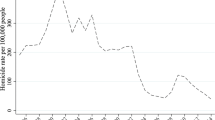Abstract
This research examines the crime prevention effects of open-street closed circuit televisions (CCTVs), installed in the city of Chuncheon, South Korea on serious crimes and disorder crimes. After controlling for the length of the month, season and temporal trend, we applied a mixed linear model for repeated measurements. We also used a Weighted Displacement Quotient (WDQ) to analyze the crime-reduction effects of each open-street CCTV location. The results of a mixed linear model showed that, on average, open-street CCTV did not show a statistically significant effect on the reduction of serious crimes or disorder crimes. However, the analysis of a WDQ showed that the crime-reduction effect of open-street CCTV location depends on the characteristics of the locations. The results also showed that the effects of a diffusion of benefits were higher in serious crimes than in disorder crimes. Results are similar to findings in European and North-American contexts.

Similar content being viewed by others
References
Bowers, K.J. and Johnson, S.D. (2003) Measuring the geographical displacement and diffusion of benefit effects of crime prevention activity. Journal of Quantitative Criminology 19 (3): 275–301.
Caplan, J.M., Kennedy, L.W. and Petrossian, G. (2011) Police-monitored CCTV cameras in Newark, NJ: A quasi-experimental test of crime deterrence. Journal of Experimental Criminology 7 (3): 255–274.
Farrington, D.P., Gill, M., Waples, S.J. and Argomaniz, J. (2007) The effects of closed-circuit television on crime: Meta-analysis of an English national quasi-experimental multi-site evaluation. Journal of Experimental Criminology 3 (1): 21–38.
Gill, M. (ed.) (2006) CCTV: Is it effective? In: The Handbook of Security. New York: Palgrave Macmillan, pp. 438–461.
Gill, M. and Spriggs, A. (2005) Assessing the Impact of CCTV. London: Research, Development and Statistics Directorate, (Home Office).
La Vigne, N.G., Lowry, S.S., Dwyer, A.M. and Markman, J.A. (2011a) Using Public Surveillance Systems for Crime Control and Prevention: A Practical Guide for Law Enforcement and Their Municipal Partners. Wahsington DC: Urban Institute, http://www.urban.org/publications/412402.html, accessed 23 October 2011.
La Vigne, N.G., Lowry, S.S., Markman, J.A. and Dwyer, A.M. (2011b) Evaluating the Use of Public Surveillance Cameras for Crime Control and Prevention. Wahsington DC: Urban Institute, http://www.urban.org/publications/412403.html, accessed 23 October 2011.
Norris, C. and Armstrong, G. (1999) The Maximum Surveillance Society: The Rise of CCTV. Oxford: Berg.
Phillips, C. (1999) A review of CCTV evaluations: Crime-reduction effects and attitudes towards its use. Crime Prevention Studies 10: 123–155.
Ratcliffe, J.H. (2006) Video Surveillance of Public Places. Problem-Oriented Guides for Police Response Guides Series. No. 4. Washington DC: Office of Community Oriented Policing Services. U.S. Department of Justice.
Ratcliffe, J.H., Taniguchi, T. and Taylor, R.B. (2009) The crime-reduction effects of public CCTV cameras: A multi-method spatial approach. Justice Quarterly 26 (4): 746–770.
Raudenbush, S.W. and Bryk, A.S. (2002) Hierarchical Linear Models: Applications and Data Analysis Methods. Thousand Oaks, CA: Sage.
Short, E. and Ditton, J. (1998) Seen and now heard: Talking to the targets of open street CCTV. British Journal of Criminology 38 (3): 404–428.
Sivarajasingam, V. and Shepherd, J.P. (1999) Effect of closed circuit television on urban violence. Journal of Accident & Emergency Medicine 16 (4): 255–257.
Snijders, T. and Bosker, R. (1999) Multilevel Analysis: An Introduction to Basic and Advanced Multilevel Modeling. Thousand Oaks, CA: Sage.
Surette, R. (2006) CCTV and citizen guardianship suppression: A questionable proposition. Police Quarterly 9 (2): 100–125.
Waples, S., Gill, M and Fisher, P. (2009) Does CCTV displace crime? Criminology & Criminal Justice 9 (2): 207–224.
Webster, W.R. (2004) The diffusion, regulation and governance of closed-circuit television in the UK. Surveillance & Society 2 (2): 230–250.
Welsh, B.C. and Farrington, D.P. (2002) Crime Prevention Effects of Closed Circuit Television: A Systematic Review. Home Office Research Study, No. 252. London: Home Office.
Welsh, B.C. and Farrington, D.P. (2003) Effects of closed-circuit television on crime. The Annals of the American Academy of Political and Social Science 587 (1): 110–135.
Welsh, B.C. and Farrington, D.P. (2004) Surveillance for crime prevention in public space: Results and policy choices in Britain and America. Criminology & Public Policy 3 (2): 497–526.
Welsh, B.C. and Farrington, D.P. (2009) Public area CCTV and crime prevention: An updated systematic review and meta-analysis. Justice Quarterly 26 (4): 716–745.
Williams, D. and Ahmed, J. (2009) The relationship between antisocial stereotypes and public CCTV systems: Exploring fear of crime in the modern surveillance society. Psychology, Crime & Law 15 (8): 743–758.
Wilson, D. and Sutton, A. (2003) Open-Street CCTV in Australia. Trends & Issues in Crime and Criminal Justice, No. 271. Canberra, Australia: Australian Institute of Criminology.
Author information
Authors and Affiliations
Corresponding author
Rights and permissions
About this article
Cite this article
Lim, H., Kim, C., Eck, J. et al. The crime-reduction effects of open-street CCTV in South Korea. Secur J 29, 241–255 (2016). https://doi.org/10.1057/sj.2013.10
Published:
Issue Date:
DOI: https://doi.org/10.1057/sj.2013.10



